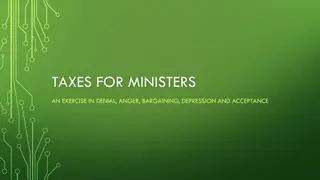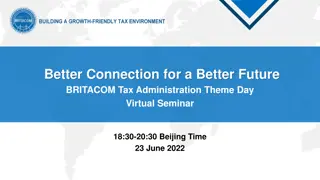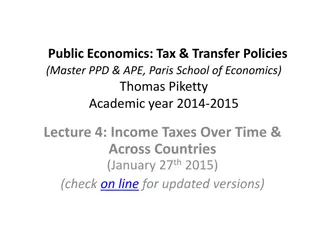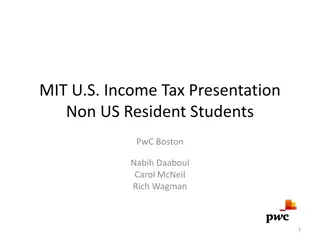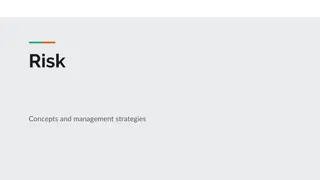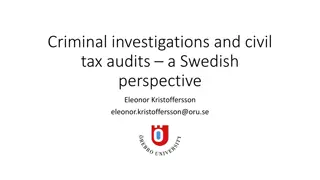Embedding Risk Management in Tax Administration
Imagine receiving directions to a friend's house in a foreign city after being away for years. This scenario parallels the need for effective risk management within tax administrations. Integrating risk management into tax processes and decision-making is crucial for enhancing compliance and achieving revenue objectives. Explore the importance of embedding risk management practices within tax administrations to drive voluntary compliance and strategic decision-making.
Uploaded on Feb 25, 2025 | 0 Views
Download Presentation

Please find below an Image/Link to download the presentation.
The content on the website is provided AS IS for your information and personal use only. It may not be sold, licensed, or shared on other websites without obtaining consent from the author.If you encounter any issues during the download, it is possible that the publisher has removed the file from their server.
You are allowed to download the files provided on this website for personal or commercial use, subject to the condition that they are used lawfully. All files are the property of their respective owners.
The content on the website is provided AS IS for your information and personal use only. It may not be sold, licensed, or shared on other websites without obtaining consent from the author.
E N D
Presentation Transcript
RISK MANAGEMENT EMBEDDING RISK MANAGEMENT IN TAX ADMINISTRATION 2/25/2025 1
OUTLINE INTRODUCTION AN INTELLIGENCE FRAMEWORK GATHERING TAXPAYERS DATA DEVELOPING TAXPAYER KNOWLEDGE ANALYZING COMPLIANCE BEHAVIOR INFLUENCES ON TAXPAYERS BEHAVIOR DRIVERS OF COMPLIANCE BEHAVIOR CONCLUSION CASE STUDY 2/25/2025 2
INTRODUCTION Imagine a friend of yours has given you a direction to his house after you have been out of the country for several years, especially in a city like, hum, Lagos. When you pass the freeway, drive to the right and go straight. Look for the bamboo club and take the other lane on the left and then go until you pass the hand-pump. There are some houses in the area. Ask for me in the second apartment. If you don t see me, please call me on 07778-7590-2230. I think it is better you call your friend now! 2/25/2025 3
INTRODUCTION Note the following seemingly clear but rather vague statements: Pay your realty taxes on time. Capital allowances are chargeable on assets in the pool at the end of the year. Transfer of assets between related parties attracts no capital gain tax. Personal deductions are limited to medical expenses except otherwise provided in this code. How are we to interpret and apply these statements? 2/25/2025 4
INTRODUCTION Like in every other organization, risk management should not be a stand-alone activity, separate from the main activities and processes of revenue authorities. Risk management should be part of the responsibilities of all levels of management, from executive management to line management and floor employees. It should be an integral part of all processes, including strategic planning, project and change management processes. 2/25/2025 5
INTRODUCTION Risk management helps managers make informed decisions about the operations of an organization. The value derives from this help is indispensable to achieving the mission and objectives of revenue authorities. More than ever before, compliance risk management is taking center stage in the daily operations of revenue authorities. It has yielded unprecedented increase in the level of voluntary compliance. 2/25/2025 6
INTRODUCTION Embedding risk management into tax administrations involves deliberate steps to gather, analyze and develop knowledge and intelligence from taxpayers and third party data. The knowledge and intelligence developed can be used to induce voluntary compliance together with other appropriate methods to enforce compliance with tax legislations. This provides opportunities for tax administrations to trump taxpayers in an ever increasing complex business environment. 2/25/2025 7
INTRODUCTION Embedding risk management in a revenue authority involves the following activities: Establishing an intelligence framework; Gathering and analyzing taxpayers data; Developing knowledge about taxpayers; Analyzing compliance behavior; Understanding influences on taxpayers behavior; and Recognizing drivers of taxpayers compliance behavior. 2/25/2025 8
ESTABLISHING INTELLIGENCE FRAMEWORK An intelligence framework is a structured knowledge and understanding that allows tax administrations to perfectly predict taxpayers compliance behavior. An intelligence is the highest level of knowledge and understanding about a subject matter that allows an individual to make accurate, complete and reliable prediction regarding the subject matter. 2/25/2025 9
ESTABLISHING INTELLIGENCE FRAMEWORK An intelligence framework is like fitting a jigsaw puzzle together to discover the image that lie behind the puzzle. By fitting fragmented taxpayers data together, tax authorities can learn a great deal about taxpayers behaviors in ways that they are able to predict future compliance behavior with reasonable certainty. Developing an intelligence framework takes great deal of time, effort and resources but the payoffs far exceed those resources. 2/25/2025 10
ESTABLISHING INTELLIGENCE FRAMEWORK An effective intelligence framework answers the following questions: What is happening? Who is doing it? Why is it happening? How is it happening? Where is it happening? When is it happening? 2/25/2025 11
ESTABLISHING INTELLIGENCE FRAMEWORK Sample Unit Level Information and Intelligence Macro level International trade and commerce Prices of produce on the world market Free trade vs protectionism Health of local economy Government regulations Socio-cultural factors Business and Micro level Compliance history and credit rating Capital structure, liquidity and profitability Corporate governance framework Nature, sizes and complexity of business Business competitiveness and intensity Management integrity and operating style Business formality and ownership interest Household income and purchasing power Level of automation and use of high tech. 2/25/2025 12
GATHERING TAXPAYER DATA The first step in building an intelligence framework is gathering, grouping and analyzing data. The first sources of data are those of taxpayers, such as: Business registration; Beneficial owners; Tax registration; Property registration, if any; Tax return records; Financial statements; Court records, if any; 2/25/2025 13
GATHERING TAXPAYER DATA Key partners and associates; Key customers and suppliers; Registered address, contact number and contact person; Credit rating and history of compliance with laws and regulations; Bank records; Scope of operation; Major shareholders; Previous audit results, if any; Board and executive management composition; etc. 2/25/2025 14
GATHERING TAXPAYER DATA Other sources of data include: Power and utility companies; Other government departments; Company registry; Law enforcement agencies; Other revenue authorities; Foreign governments; Trade associations; Import and export statistics; Industry and market data; etc. 2/25/2025 15
DEVELOPING KNOWLEDGE OF TAXPAYER Gathering taxpayers data is not sufficient and provides no benefit to tax authorities. The data must be grouped, analyzed and structured in ways that provide discernable patterns that explain current and future compliance behavior. Data must be captured and stored in a format that allows logical manipulations using appropriate data extraction, analysis and matching tools and techniques. 2/25/2025 16
DEVELOPING KNOWLEDGE OF TAXPAYER For example, annual turnover can be compared with industry average, economic data or those of competitors to uncover possible under declaration of turnover. Import records can be matched against cost of sales and compared with industry average to determine whether cost of sales is deliberately overstated. 2/25/2025 17
DEVELOPING KNOWLEDGE OF TAXPAYER Economic data can be compared with cash flow forecast and bank records to determine whether a taxpayer will be able to settle existing tax debts. Data can also be triangulated. For example, matching data from company registry against property registry, financial statements and tax filings may expose possible tax fraud or money laundering scheme. 2/25/2025 18
DEVELOPING KNOWLEDGE OF TAXPAYER Accurate, complete and reliable knowledge of taxpayers is indispensable to revenue authorities. Tax administrations need to build and retain knowledge, skills, expertise and competencies which can be translated to such knowledge and intelligence. The use of advanced information technology, data warehouse and data extraction, analysis tools and techniques is equally important for tax administrations. 2/25/2025 19
ANALYZING COMPLIANCE BEHAVIOR As businesses become more and more complex, it is imperative for revenue authorities to adapt and keep pace with new developments. Understanding taxpayers compliance behavior is not a guesswork. Several indicators of compliance behavior are now supported by robust empirical research. Both economic and non-economic explanations of compliance behavior have predictive force. 2/25/2025 20
ANALYZING COMPLIANCE BEHAVIOR Taxpayers adopt a range of motivational postures in their response to the demands of revenue authorities. The tax system itself, both law and administration can be a shaper of taxpayers compliance behavior. Research has identified two broad approaches to the problem of compliance. The first stems from an economic rationality perspective and has been developed using economic analysis. 2/25/2025 21
ANALYZING COMPLIANCE BEHAVIOR The second is concerned with wider behavioral issues and draws from concepts in psychology and sociology. Economic factors: Financial burden there appears to be a relationship between the amount of tax owed and taxpayers compliance behavior. For instance, if taxpayer has tax liability that can easily be paid, it may be willing to pay. However, if the liability is large, potentially threatening the viability of the business, the owner may avoid paying at all or may try to adjust the data reported so as to incur a smaller, but incorrect, tax liability. 2/25/2025 22
ANALYZING COMPLIANCE BEHAVIOR Economic factors: The cost of compliance taxpayers appear to have a number of common costs of having to comply with their tax obligations over and above the actual amount of tax they pay. These include the time taken to complete requirements, the costs of having to rely on accountants and the indirect costs associated with the complexity of tax legislations. These can include psychological costs such as stress that comes from not being certain that they have met all the tax rules or even knowing what those rules are. 2/25/2025 23
ANALYZING COMPLIANCE BEHAVIOR Economic factors: Disincentives investigations into the impact of deterrents, such as financial penalties and threats of prosecutions, suggest that they may have a time limited effect on compliance behavior of taxpayers. However, those who are compliant want those who are non-compliant to be punished. If the revenue authority does not deter non-compliant taxpayers with heavy penalties and prosecutions, those who are complaint will have disincentives to comply. 2/25/2025 24
ANALYZING COMPLIANCE BEHAVIOR Economic factors: Incentives giving taxpayers incentives for compliance may have a positive effect on compliance behavior by becoming more compliant. For example, giving a taxpayer an extended tax clearance certificate or special recognition at a national event may induce both compliant and non-compliant taxpayers to comply. 2/25/2025 25
ANALYZING COMPLIANCE BEHAVIOR Behavioral factors: Individual differences while many taxpayers comply with their tax obligations, some do not. Individual factors influencing behavior include gender, age, education level, moral compass, industry, personality, circumstances and personal assessment of risks. Perceived inequity taxpayers who believe that the tax system is unfair or who have person experience of unfair treatment are less likely to comply. 2/25/2025 26
ANALYZING COMPLIANCE BEHAVIOR Behavioral factors: Perception of minimum risk if a taxpayer has the opportunity not to comply and thinks that there is only a minimum risk of being detected, he or she will take the risk of non-compliance. The presumably accounts for the greater under-reporting of certain types of income. For example, salary and wage income is highly visible to a tax authority because of third party reporting. However, other forms of income may be mush less visible and therefore subject to more creative accounting. 2/25/2025 27
ANALYZING COMPLIANCE BEHAVIOR Behavioral factors: Risk taking some people view tax avoidance as a game to be played and won. They like to test their skills in avoiding their obligations and avoiding being caught. The perceived fairness of revenue authorities is important in inducing tax compliance. 2/25/2025 28
INFLUENCES ON TAXPAYERS BEHAVIOR It would be impossible, if not pointless to attempt to list all the different factors that go together to influence the attitudes and behavior of taxpayers. What we can do is provide a model for thinking about those factors, a model that will allow us to categorize the factors in a consistent manner and form to aid our understanding of taxpayers compliance behavior. This model is very useful for tax administrations to apply in their setting to understand why taxpayers behave the way they do and for effective and efficient treatment strategies. 2/25/2025 29
INFLUENCES ON TAXPAYERS BEHAVIOR There are five general categories under which the factors can be grouped: Business profile; Industry profile; Sociological factors; Economic factors; and Psychological factors. 2/25/2025 30
INFLUENCES ON TAXPAYERS BEHAVIOR Business profile: Structure sole trader, partnership, company, trust, etc. Size and age of the business; The types of activities it carries out; Focus local versus international; Its financial data capital investment, profitability, liquidity; capital structure, etc. Key customers and suppliers; Its business intermediaries; etc. 2/25/2025 31
INFLUENCES ON TAXPAYERS BEHAVIOR Industry profile: The definition and size of industry; Major participants in the industry; Profit margins; Cost structures; Industry regulations; Working patterns; Level of competition; Seasonal factors; Technology and infrastructure; etc. 2/25/2025 32
INFLUENCES ON TAXPAYERS BEHAVIOR Sociological factors: Socio-cultural norms; Ethic background; Attitude to government; Age, gender and level of experience; Educational level; Social group; etc. 2/25/2025 33
INFLUENCES ON TAXPAYERS BEHAVIOR Economic factors: Investment; Health of the economy; Demographic interest rates; The tax system; Government policies; International influence; Inflation; Market conditions; etc. 2/25/2025 34
INFLUENCES ON TAXPAYERS BEHAVIOR Psychological factors: Greed; Attitude to risk; Fear and trust; Values and philosophy; Fairness and equity; Moral compass; Opportunity to evade; etc. 2/25/2025 35
DRIVERS OF COMPLIANCE BEHAVIOR There is no easy answer to what influences taxpayer behavior either toward compliance or non-compliance. Research suggests that several factors combine to cause taxpayers to adopt sets of values, beliefs and attitudes that can be described as motivational postures. These postures, two broadly non-compliant and two broadly compliant, characterize the way individuals relate to a revenue authority and the tax system it administers. 2/25/2025 36
DRIVERS OF COMPLIANCE BEHAVIOR The disengaged - these are people who have decided not to comply. People with this attitude either deliberately evade their responsibilities or choose to opt out. Cynicism about the tax system is usually matched by cynicism about the role of government. Resisters confrontation. The system is seen as an oppressive, burdensome and inflexible. This attitude characterizes people who do not comply but who will if they can be persuaded that their concerns are being addressed. the attitude of resistance characterizes 2/25/2025 37
DRIVERS OF COMPLIANCE BEHAVIOR Triers more positive is the attitude of those who are basically willing to comply but who have difficulty in doing so and don t always succeed. They may have difficulty understanding or meeting their obligations, but their expectation is that, in any dispute, trust and cooperation will prevail. Supporters the attitude here is one of willingness to do the right thing. There is a conscious commitment to supporting the system and accepting and managing its demands. There is an acceptance of the legitimacy of the role of tax officers and belief that they are fundamentally trustworthy. 2/25/2025 38
DRIVERS OF COMPLIANCE BEHAVIOR It is important to realize that any taxpayer is capable of adopting any of the attitudes described at different times. It is also possible to adopt all of the attitudes simultaneously in relation to different issues. The attitudes are not fixed characteristics of a person or group, but reflect the interaction between the person or group and those that impose demands upon them. 2/25/2025 39
DRIVERS OF COMPLIANCE BEHAVIOR The value of this model is that it contributes to a deeper understanding of taxpayer behavior and lays the groundwork for the development of targeted strategies which encourage the motivation to do the right thing and constrain the motivation to resist or evade compliance. Understanding the general theory of taxpayers motivation can help the revenue authority shape and manage its compliance program in a strategic way. 2/25/2025 40
DRIVERS OF COMPLIANCE BEHAVIOR In the same way, understanding the factors that drive specific compliance behavior is essential to guide the selection of appropriate treatment strategies. Taking time to analyze compliance behavior assists the tax authority to address the cause of the non-compliance rather than the symptom, thereby achieving the long-term compliance outcome. 2/25/2025 41
DRIVERS OF COMPLIANCE BEHAVIOR For example, over claiming business expenses or failure to report accurately may be the non-compliant behavior that is observed and needs to be addressed. However, the driver of the behavior may be the taxpayer s need to increase cash flow in an attempt to remain competitive in the business environment where competitors routinely under-report their business income or deal in cash. Alternatively, the driver may be the taxpayer s perception that the tax rates are too high and the desire to recoup some money as compensation. 2/25/2025 42
DRIVERS OF COMPLIANCE BEHAVIOR In a situation such as this, treating the behavior (the symptom) will only have an impact on the affected taxpayer and even then only for a limited period of time. Moreover, the taxpayer concerned may actually feel hard done to have been singled out for attention when those around get away with the same behavior. This may in turn simply serve to fuel feeling of resentment to the tax system and provoke further acts of non-compliance. 2/25/2025 43
DRIVERS OF COMPLIANCE BEHAVIOR Thus, looking for the underlying cause of the behavior and selecting appropriate strategy to address it could account for a difference in outcomes between short-term, isolated compliance or even aggravated non-compliance and long-term sustainable compliance. It should not automatically be assumed that the target taxpayer is able to change behavior of its own accord. This is the reason why a tax authority must understand where the cause of the behavior problem lies. 2/25/2025 44
DRIVERS OF COMPLIANCE BEHAVIOR For example, the behavior of the target taxpayer may be to always submit tax returns late (failure to file). Further analysis and investigation might determine the cause to be third party entities not making necessary information available to the target population in a timely fashion. In this situation, penalizing the target taxpayer for its behavior is not going to fix the underlying systemic problem. 2/25/2025 45
DRIVERS OF COMPLIANCE BEHAVIOR A more effective strategy would be to work with the third party information providers to improve the timeliness of their information dissemination. Good compliance outcomes begin with good legislation. Law that is clear and unambiguous with regards to its intent and interpretation provides a solid base upon which to build administrative compliance program and compliance risk management. 2/25/2025 46
DRIVERS OF COMPLIANCE BEHAVIOR Difficult or ambiguous law creates increased opportunities for taxpayers to behave in ways that were unintended by the law. In many ways, good law underpins the tax authority s ability to deliver procedural fairness in the conduct of its administration. If taxpayers perceive the law to be unjust and inappropriate according to taxpayers mores then, inevitably, there is an increased risk of non-compliant behavior. 2/25/2025 47
DRIVERS OF COMPLIANCE BEHAVIOR Tax administration begins with the law in place. The law represents the component of the context or environment in which a revenue authority operates and it is from this environment that we discern the compliance risk associated with the administration of the law. The challenge for revenue authorities is to administer the law in a manner that sustains taxpayers confidence in their administration . 2/25/2025 48
DRIVERS OF COMPLIANCE BEHAVIOR To that end, the manner of administration must be commensurate with the level of exposure to compliance risk. Any compliance imposition on the community or sub-section of the community needs to be acceptable according to community standards. In general, the compliance costs to taxpayer associated with administration must be appropriate. Otherwise, it will create dissatisfaction and therefore lead to a decrease in taxpayer compliance. 2/25/2025 49
CONCLUSION There There are taxpayers taxpayers compliance Tax Tax laws laws must intent intent and and interpretation interpretation. . Tax Tax authorities authorities must the the laws laws to to sustain administration administration. . are economic economic and compliance behavior must be be clear clear and and psychological psychological explanations behavior. . and unambiguous unambiguous in in regards explanations of of regards to to their their must be sustain confidence confidence in in the be perceived perceived as as being being fair the tax fair in in administering administering tax system system and and its its 2/25/2025 50




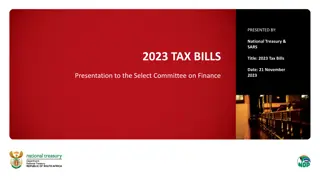

![Town of [Town Name] Real Estate Tax Rates and FY 2024 Budget Summary](/thumb/62211/town-of-town-name-real-estate-tax-rates-and-fy-2024-budget-summary.jpg)




